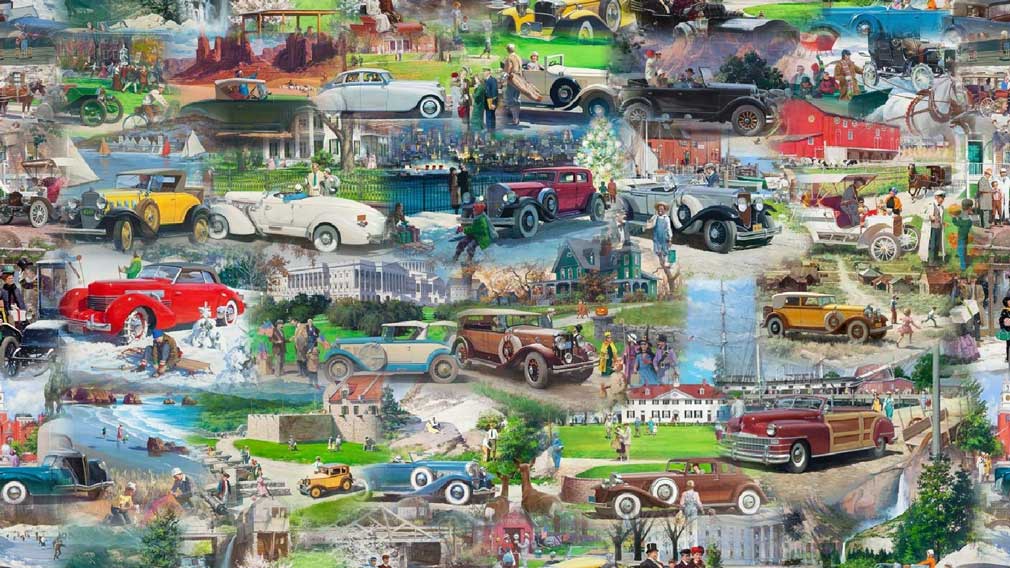Grands moments de l'automobile américaine
Greats Moments in Early American Motoring
Illustrations de Harry Anderson
de 1903 à 1947
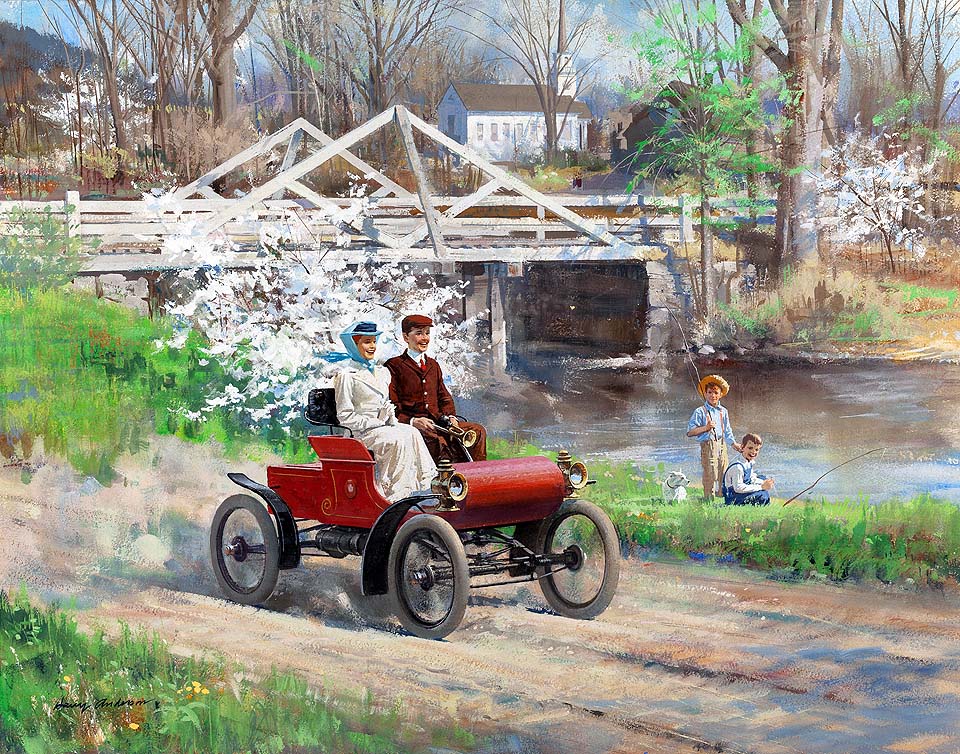
1903 Oldsmobile: Come Away with me, Lucille, in my Merry Oldsmobile
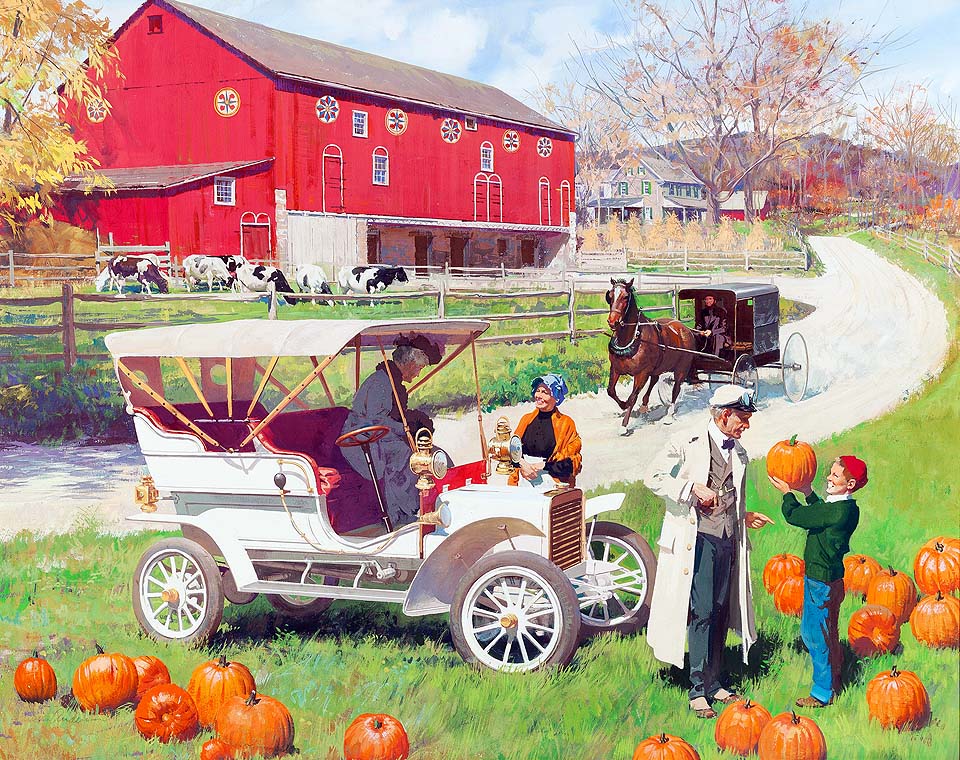
1904 Northern Rear Entrance Tonneau: A Leisurely Country Drive
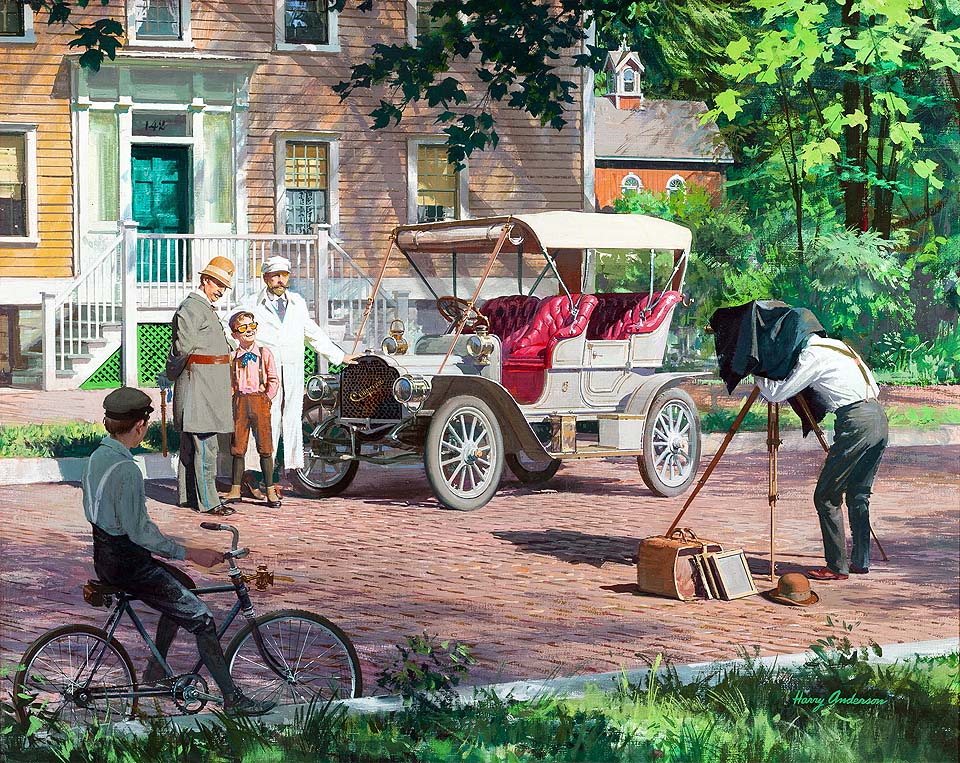
1906 Compound: The First Family Car
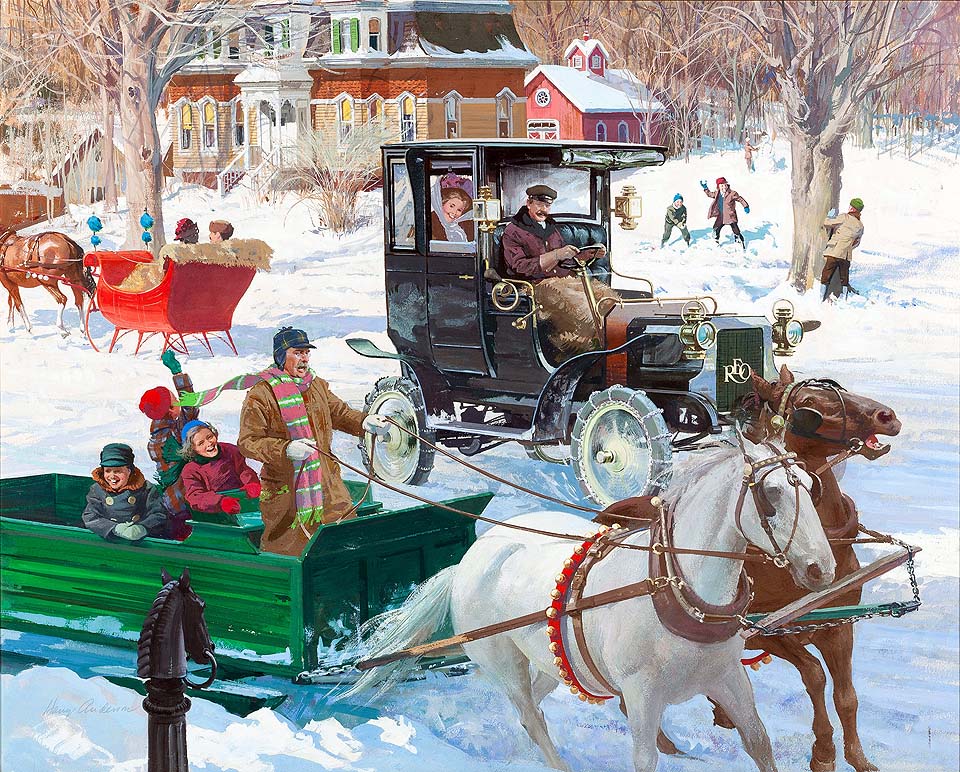
1906 Reo Depot Wagon: The Sound of Sleighbells

1909 White Steamer: The Chief Executive Goes For a Spin
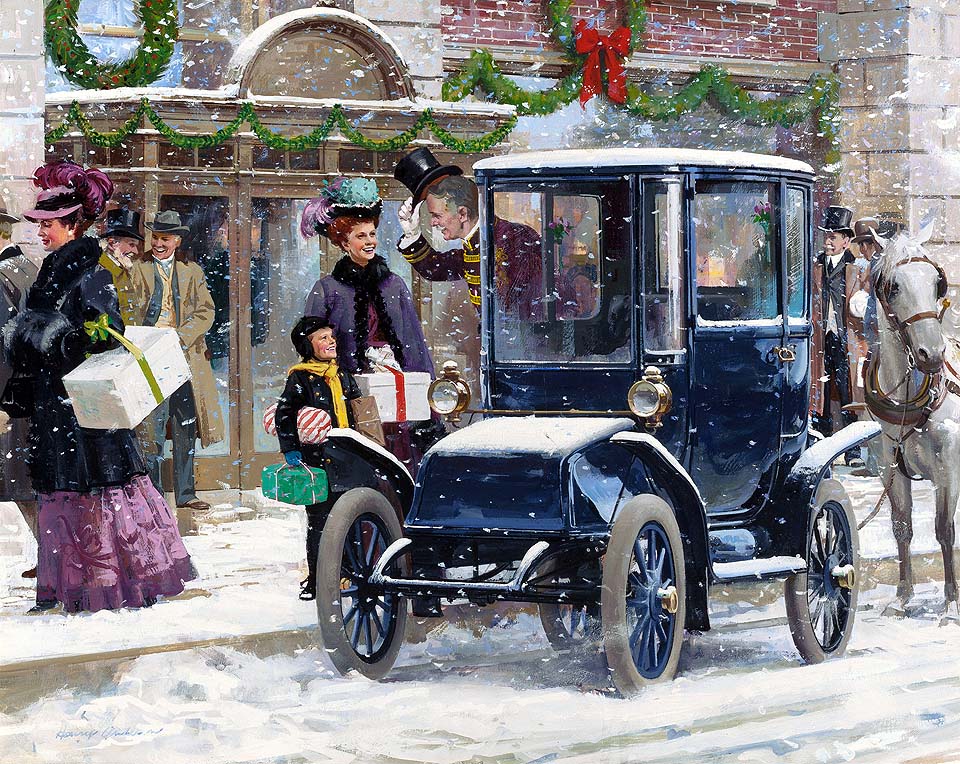
1910 Baker Electric: Milady Travels on Storage Batteries
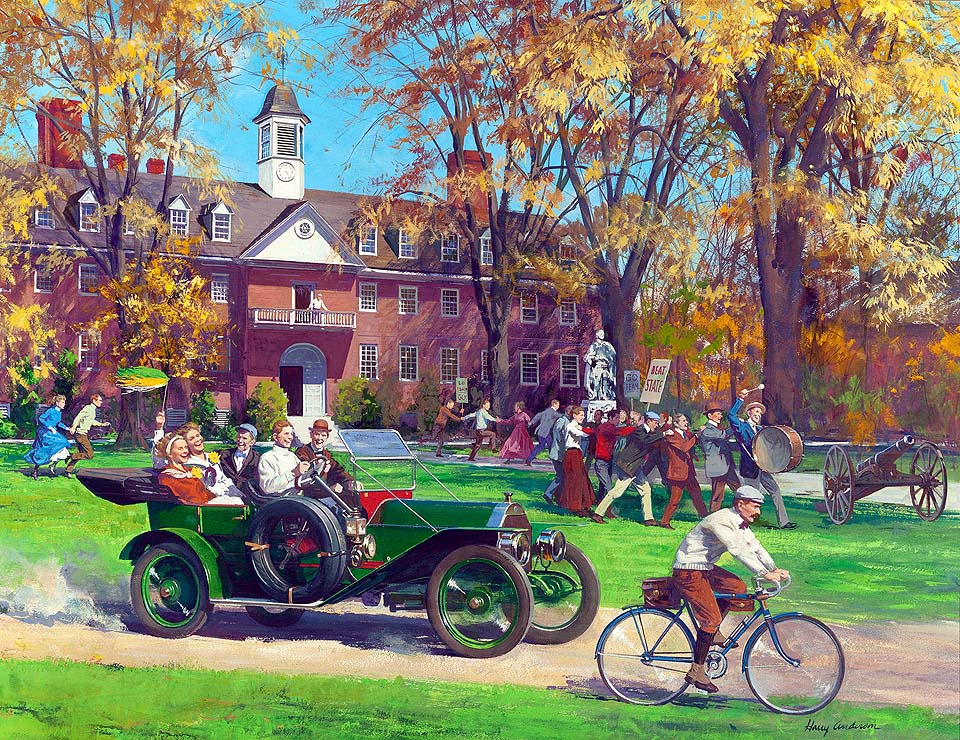
1910 Palmer Singer: Go Team Go!
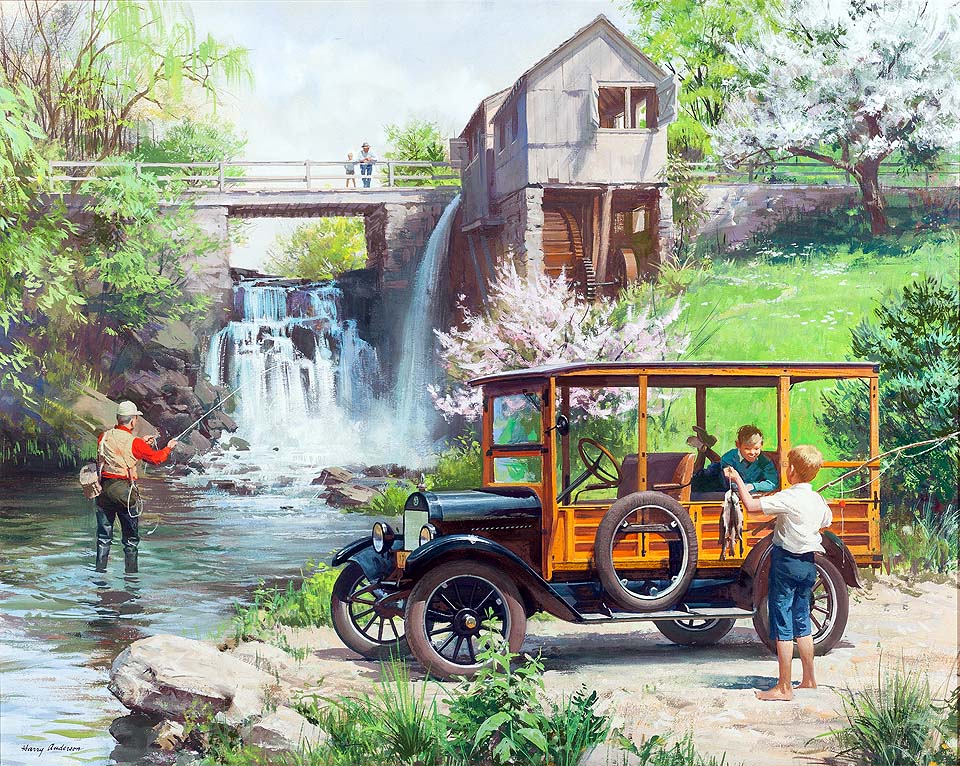
1923 Star Station Wagon: Dad's Day Off
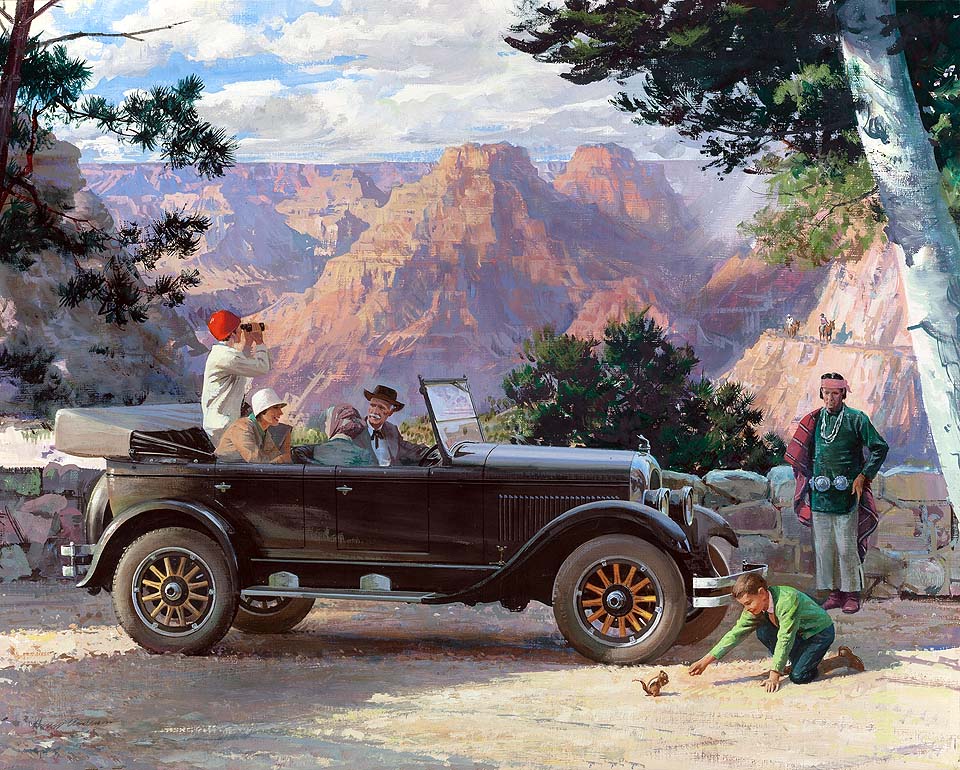
1924 Chrysler: The Open Road Invites Settlement
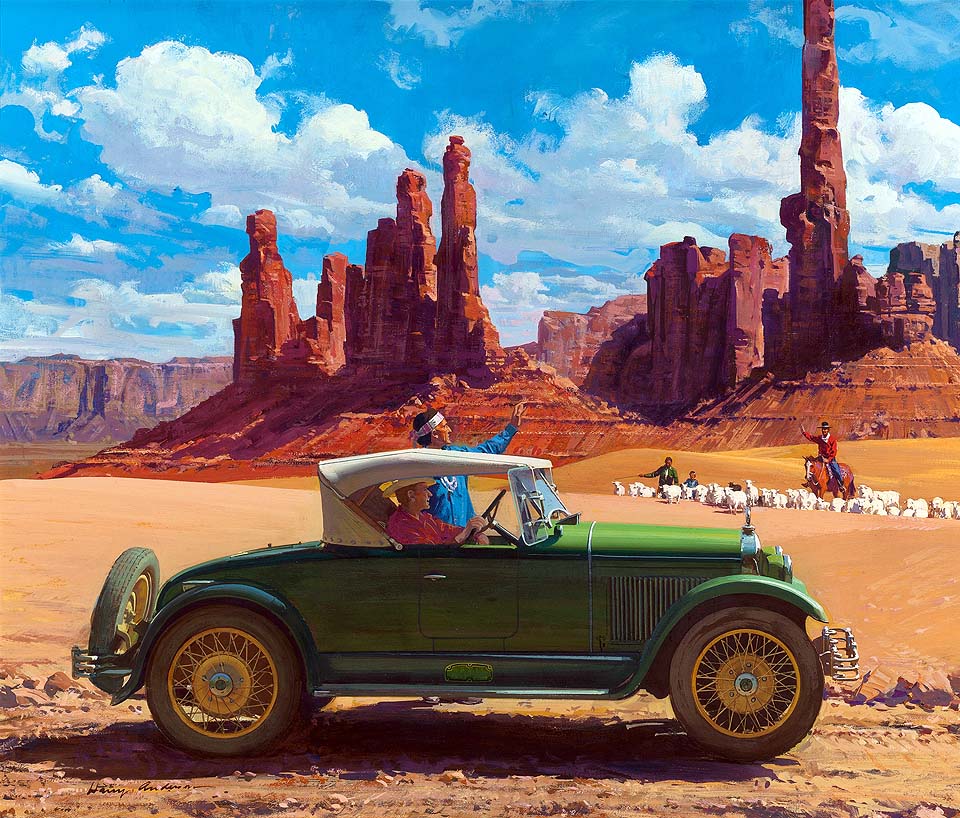
1927 Nash Four-Passenger Roadster: The Navajo Indians
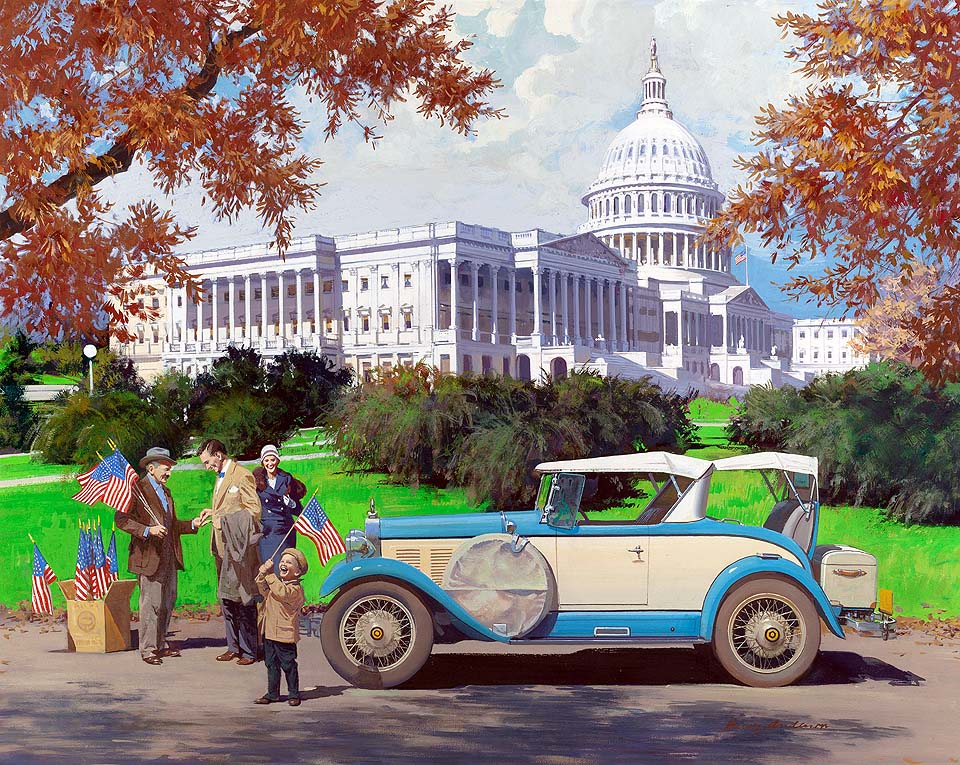
1928 Falcon-Knight Gray Ghost Roadster: Washington, D.C.
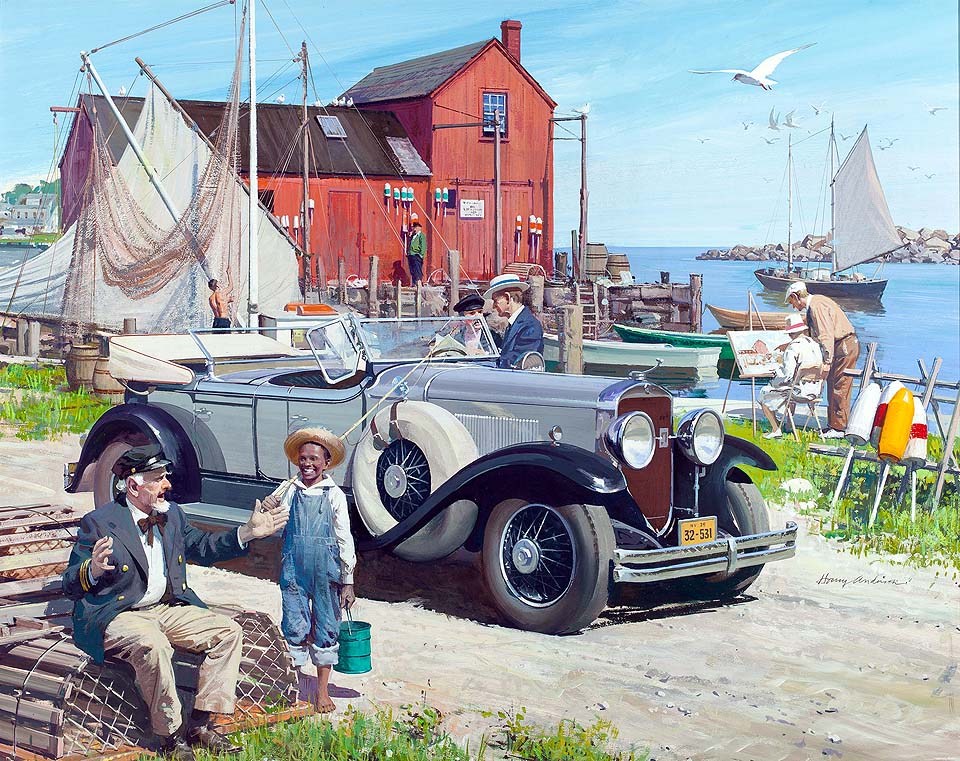
1929 Cadillac Sport Phaeton: Weathered wharves
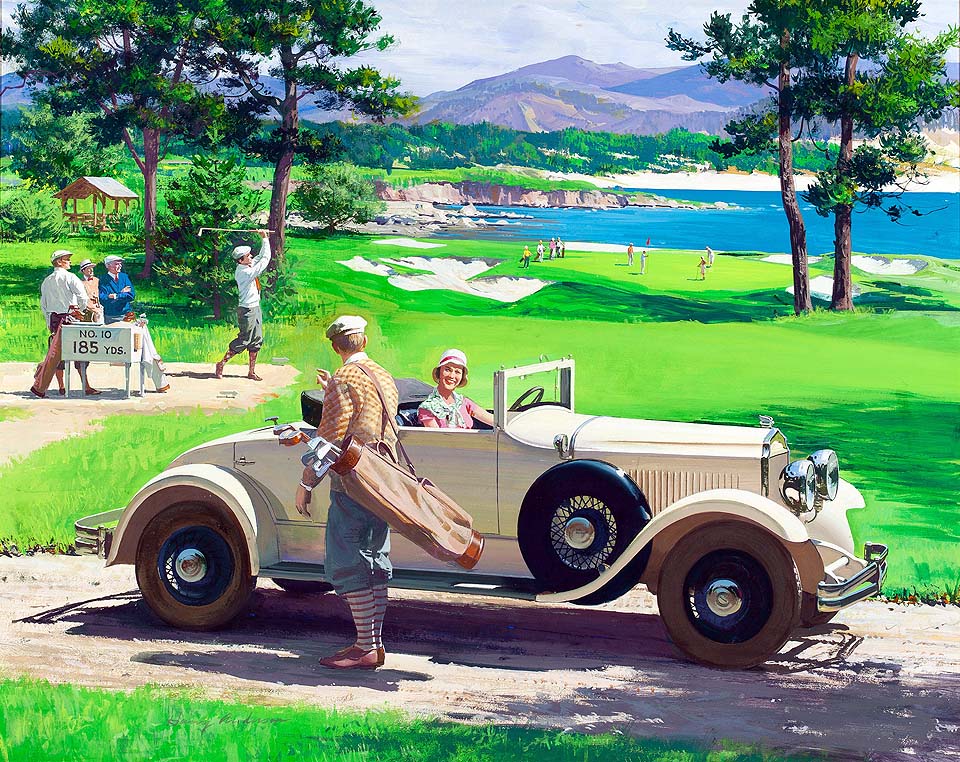
1929 Chrysler Imperial Roadster
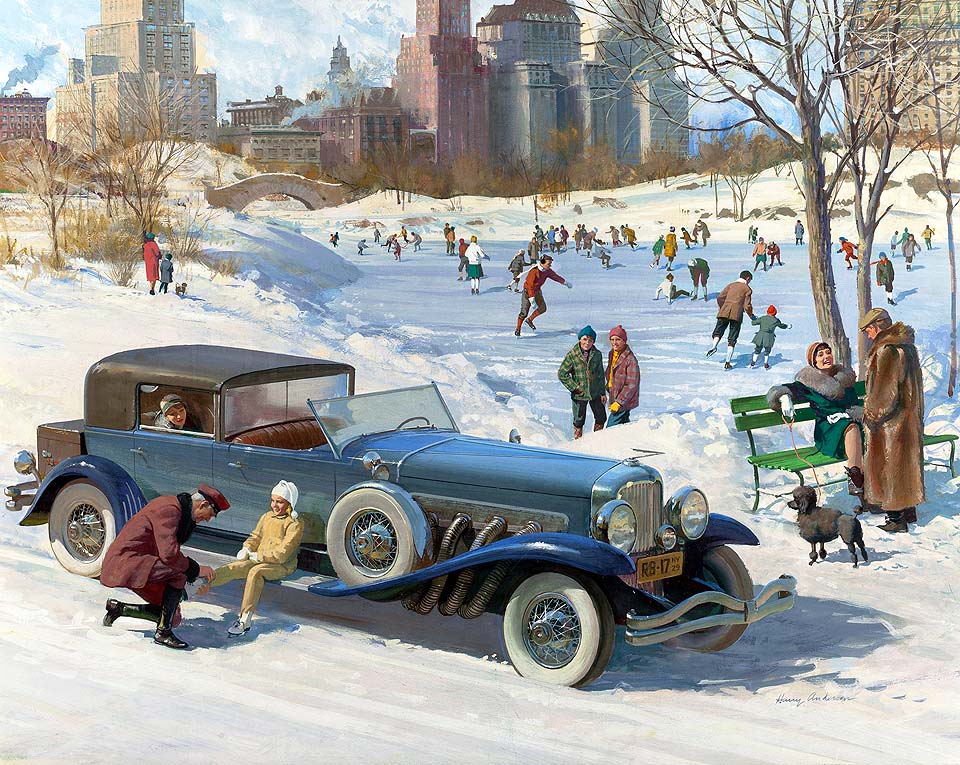
1929 Duesenberg: America's Luxury Cars
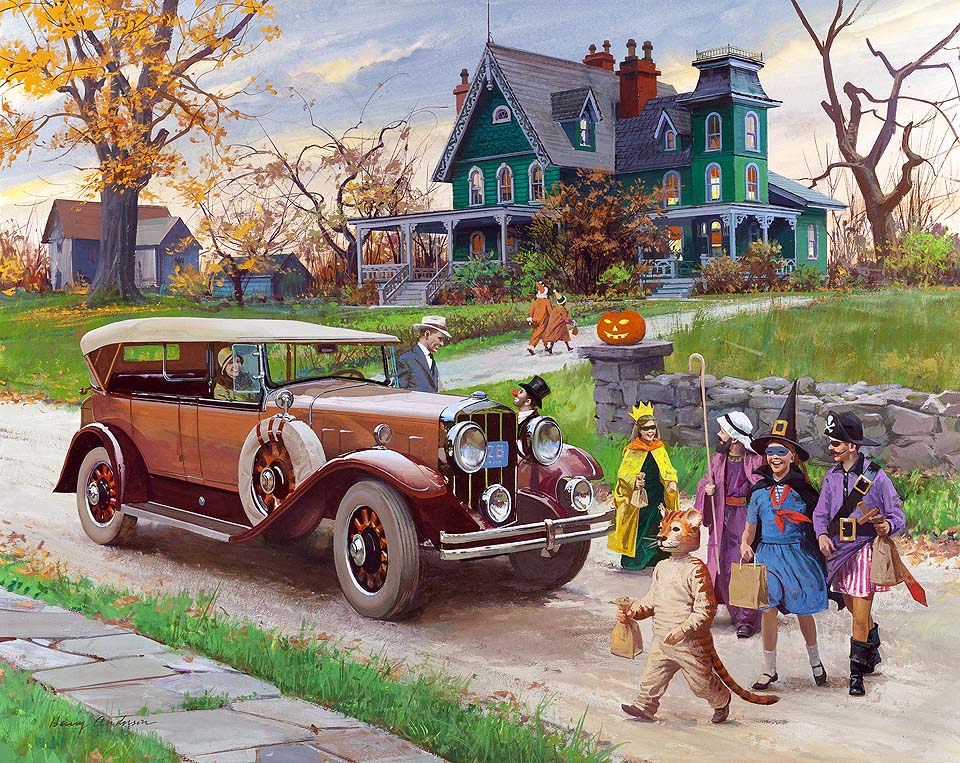
1929 Franklin Sport Touring Car: On Halloween
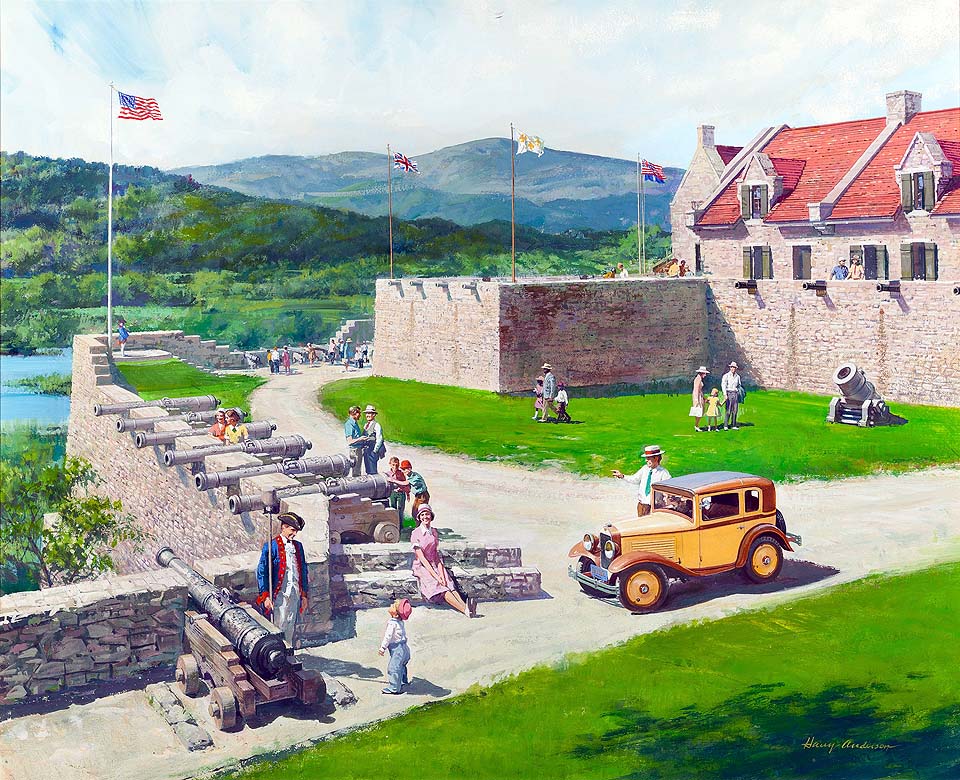
1930 Austin Bantam Coupe: Fort Ticonderoga, Ticonderoga, New York
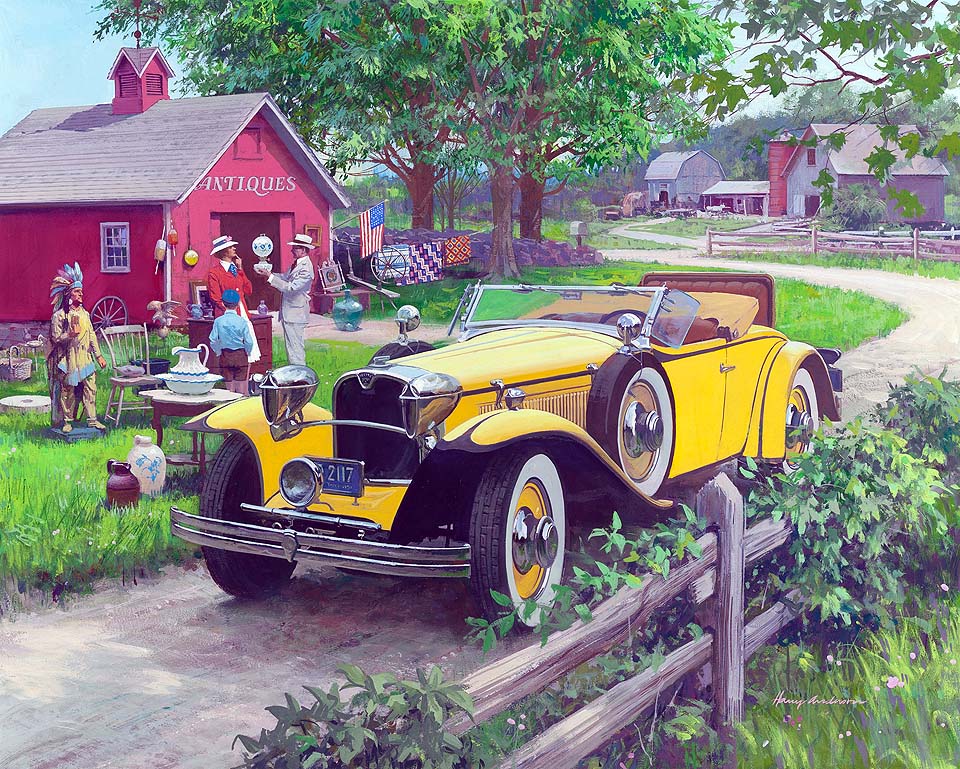
1930 Ruxton Roadster: Barn Antiques
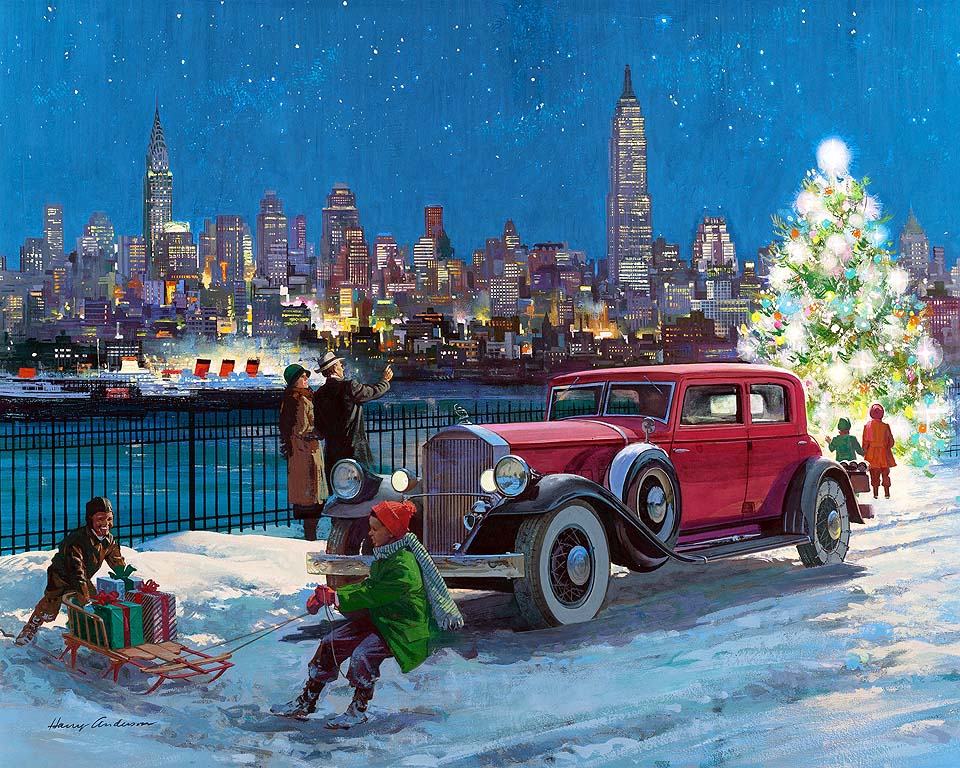
1931 Pierce-Arrow Custom Club Sedan
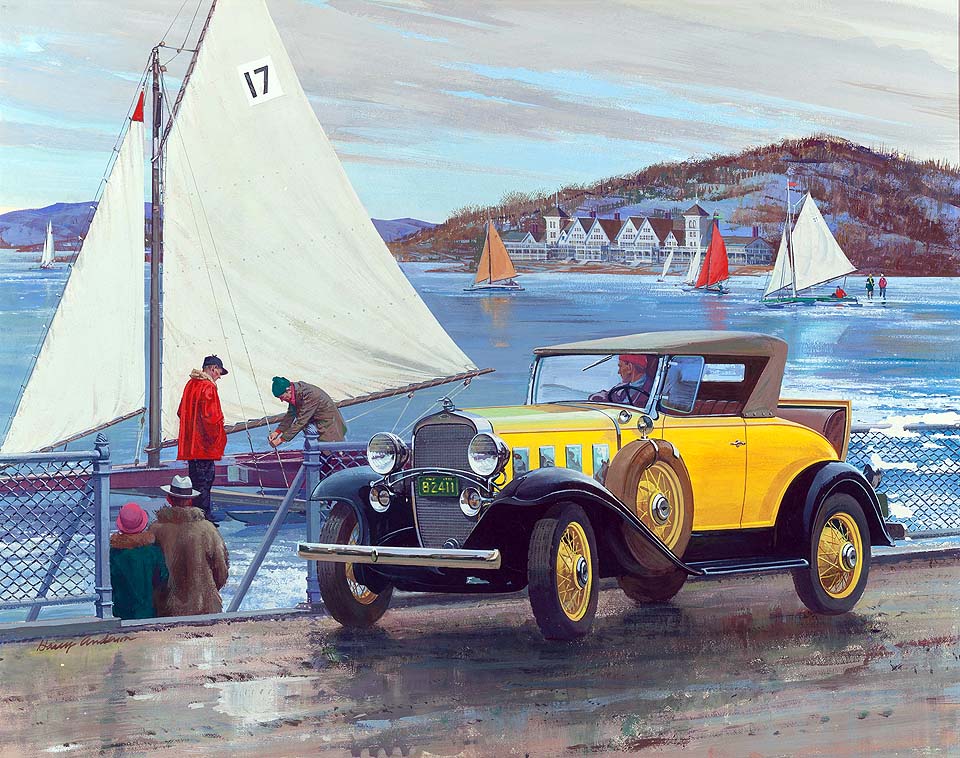
1932 Chevrolet Sport Roadster: A Good Freeze and a gentle breeze
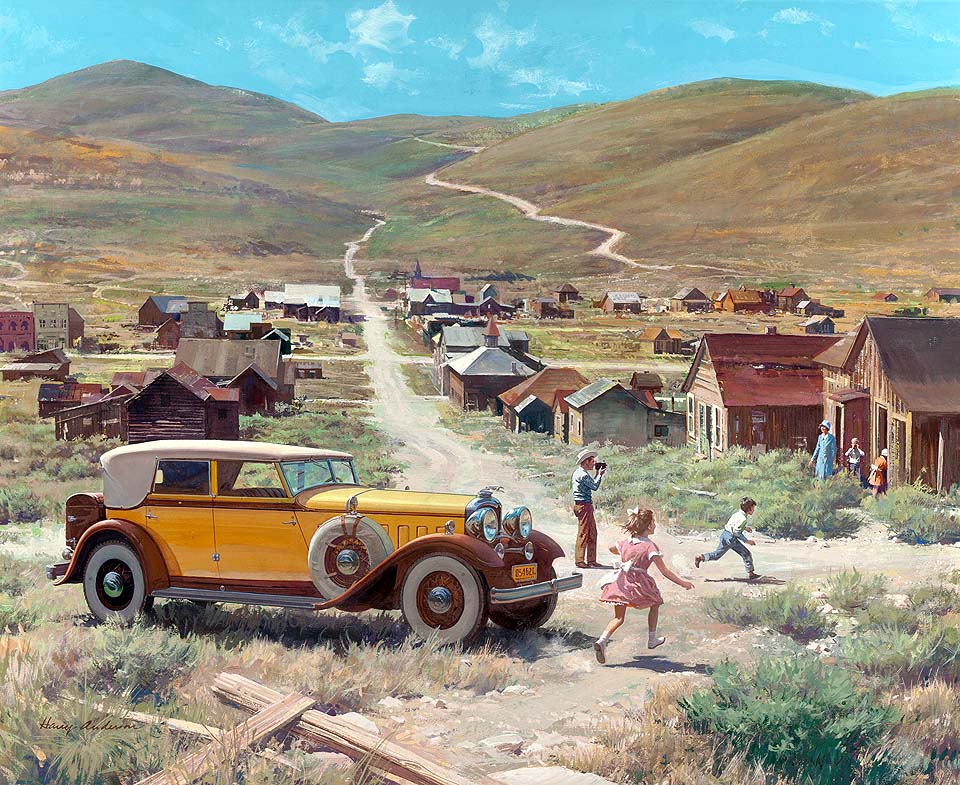
1932 Lincoln Convertible Sedan: Gold Ghost Town, Bodie, California
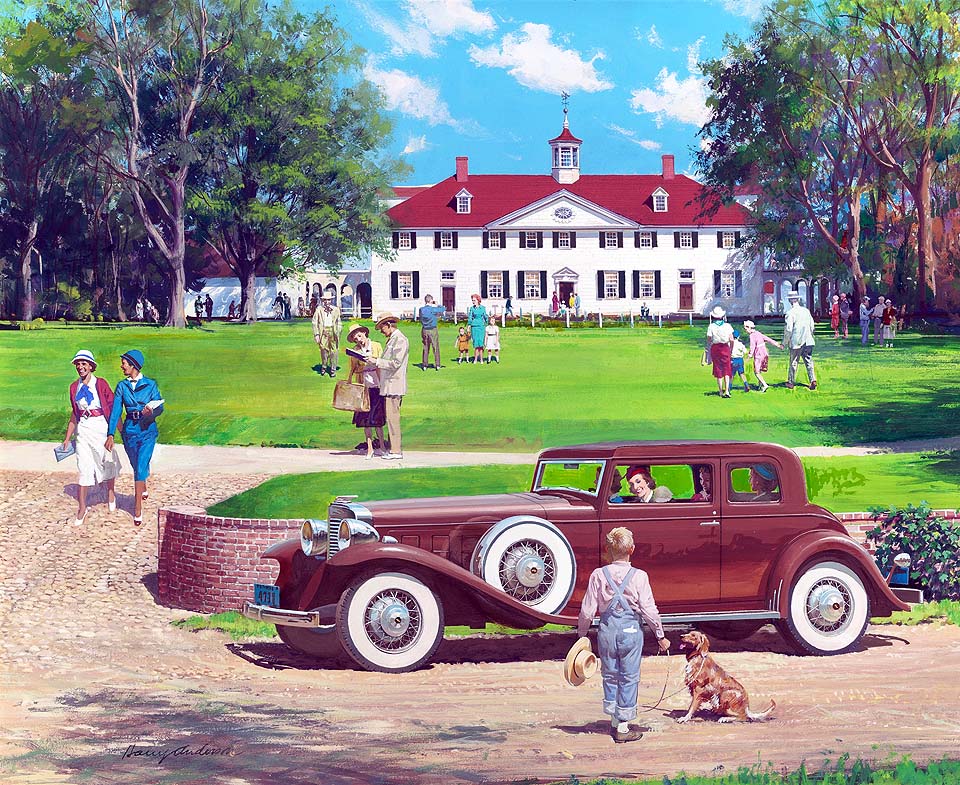
1933 Marmon V-16 Coupe: Mt. Vernon, Virginia
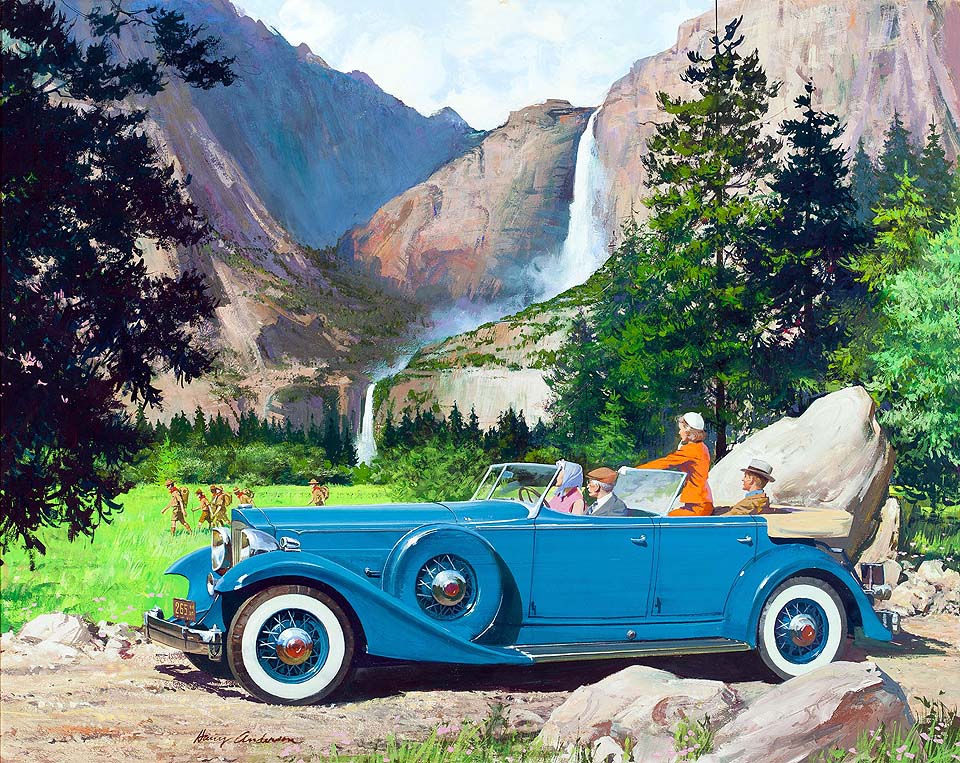
1933 Packard Sport Phaeton: Down from the granite heights (Yosemite Falls)
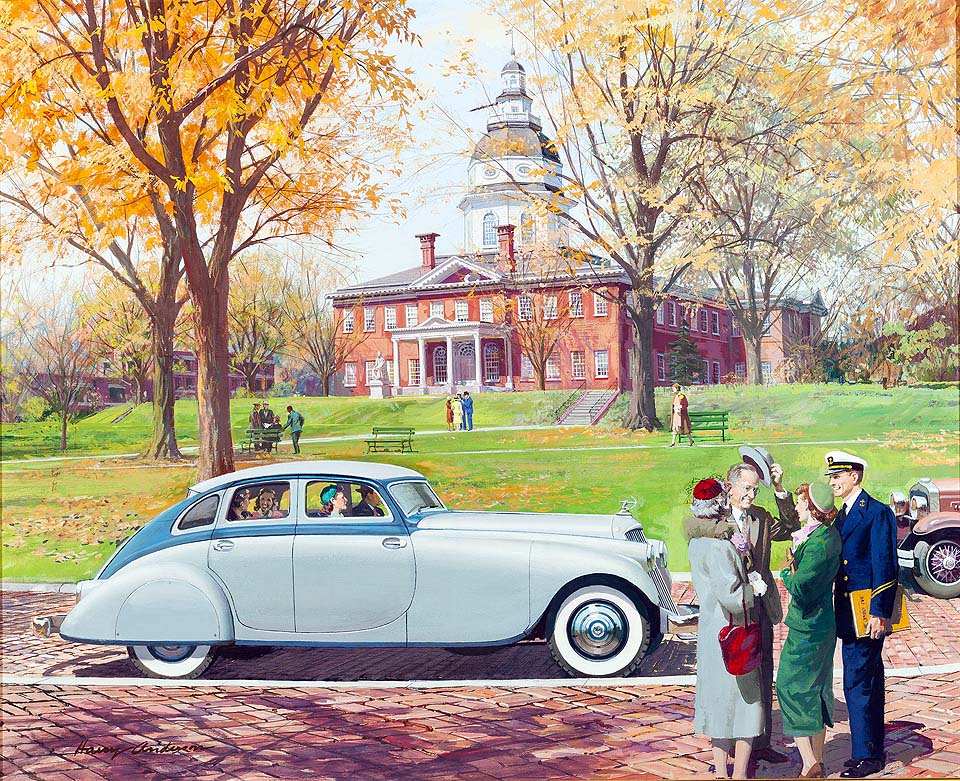
1933 Pierce Silver Arrow: The Maryland State House
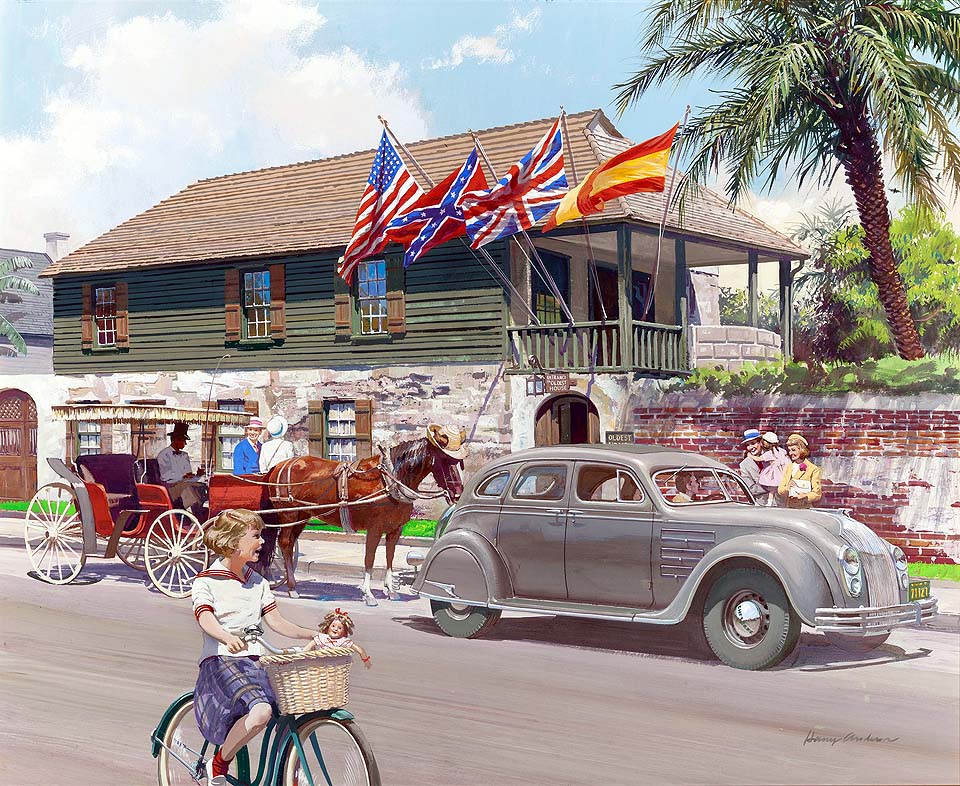
1934 Chrysler Airflow Sedan: The Oldest House, St. Augustine, Florida
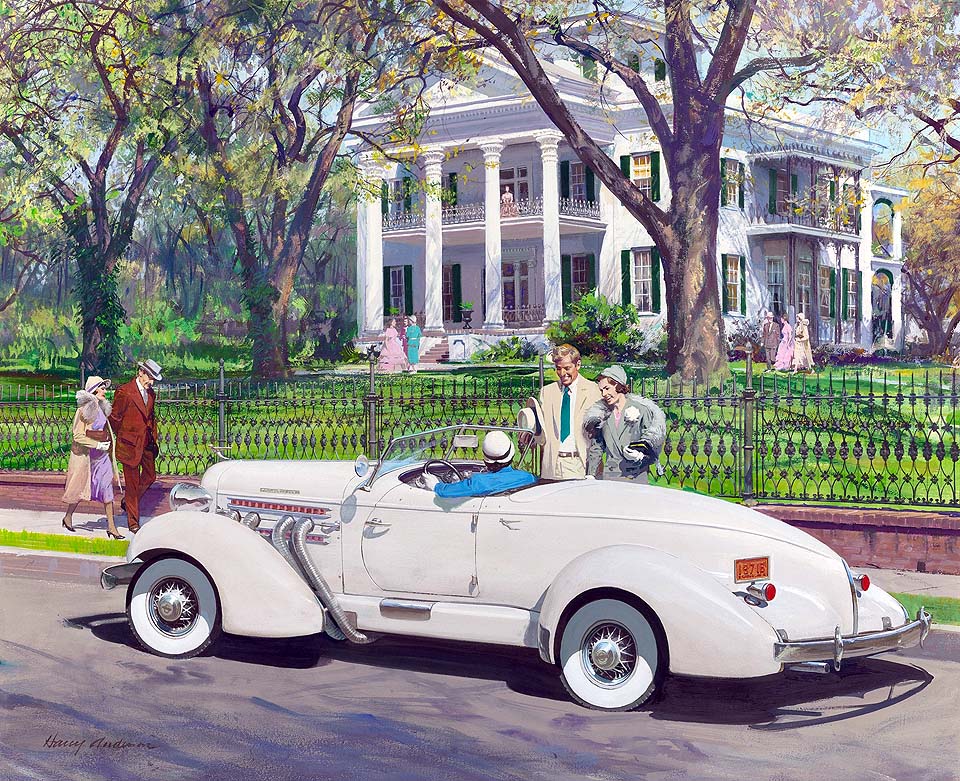
1935 Auburn Boat-tail Speedster: Stanton Hall, Natchez, Mississippi
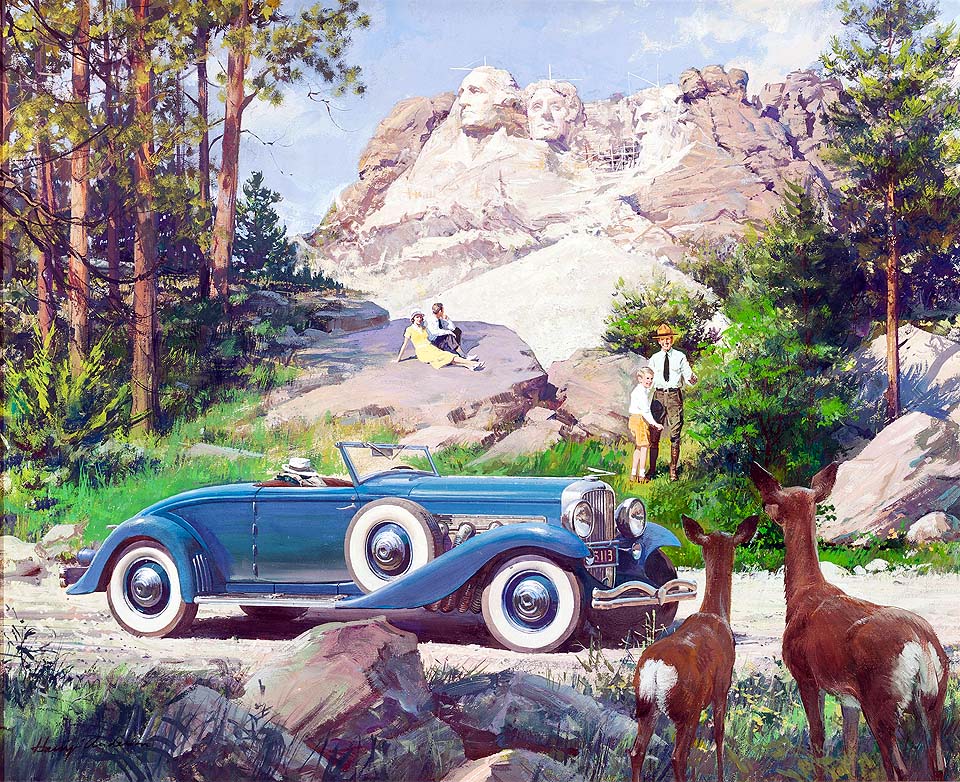
1936 Duesenberg Model JN Convertible Coupe: Mt. Rushmore National Monument, Black Hills, South Dakota
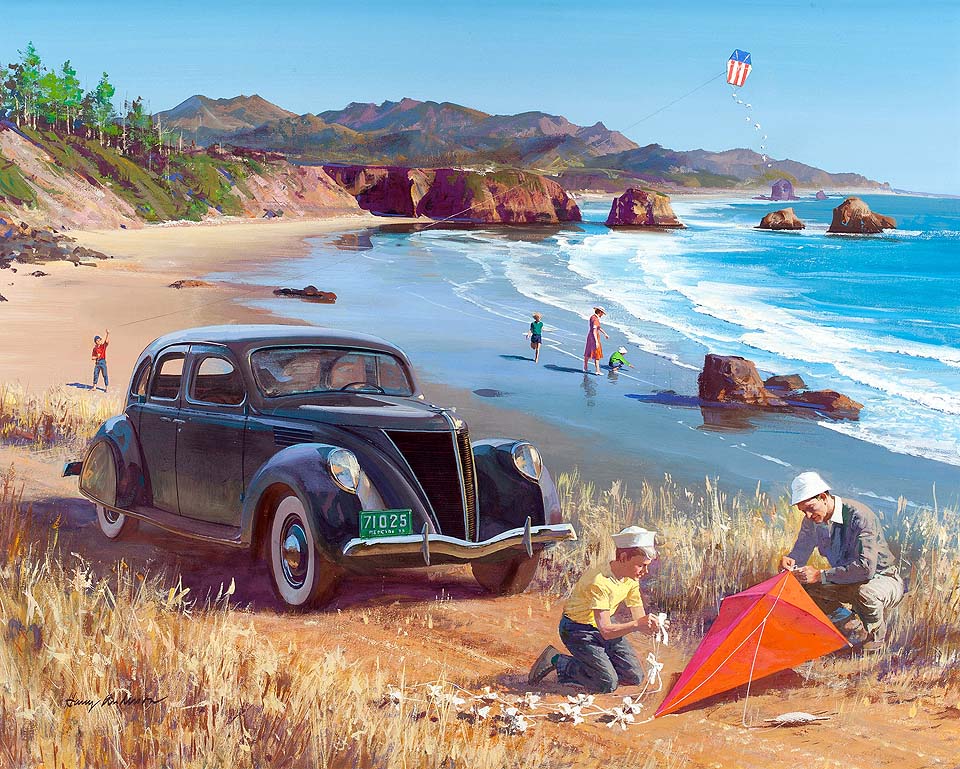
1936 Lincoln-Zephyr Sedan: Flying Kites on the Beach
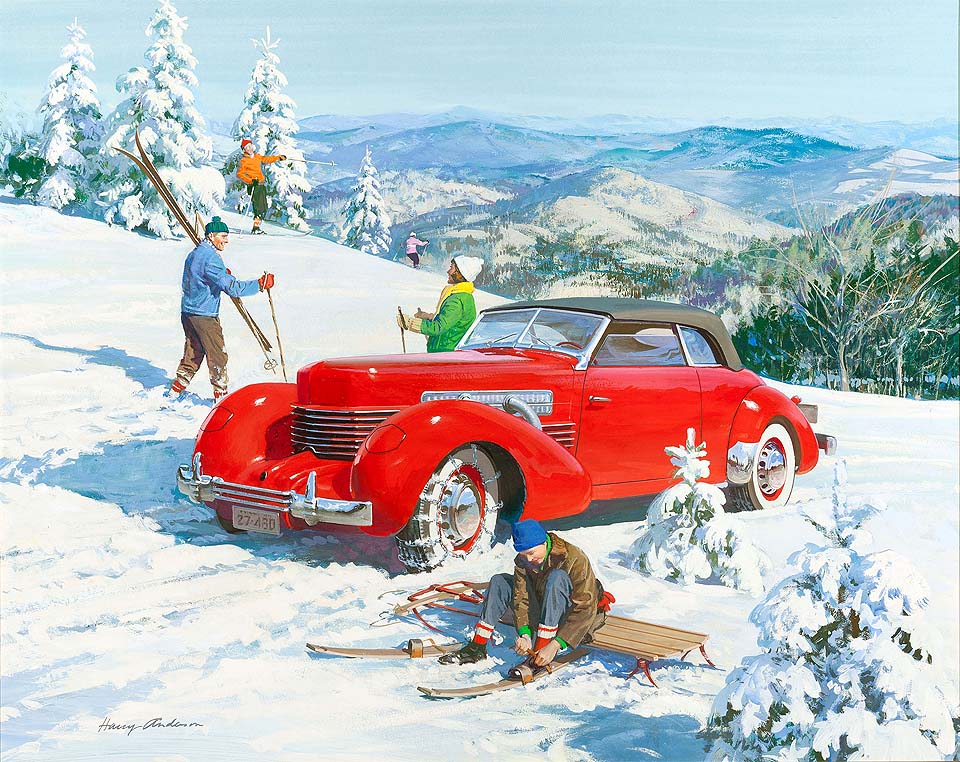
1937 Cord '812' Convertible Coupe: For pioneer American skiers
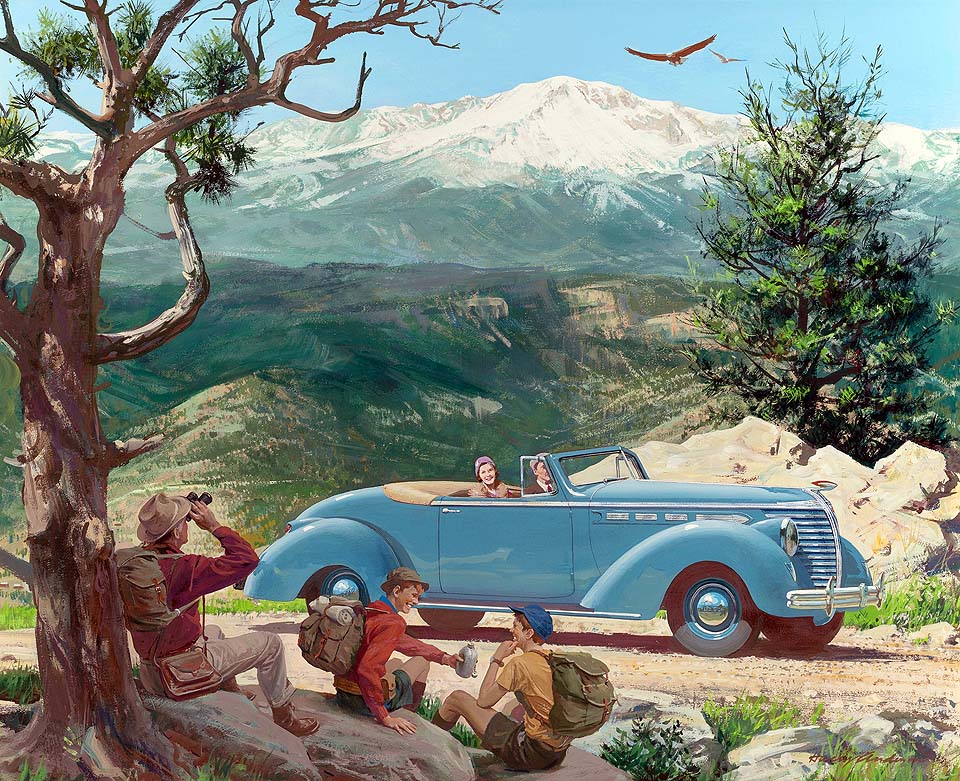
1938 Hudson Eight Convertible Coupe: Pikes Peak, Colorado Springs, Colorado
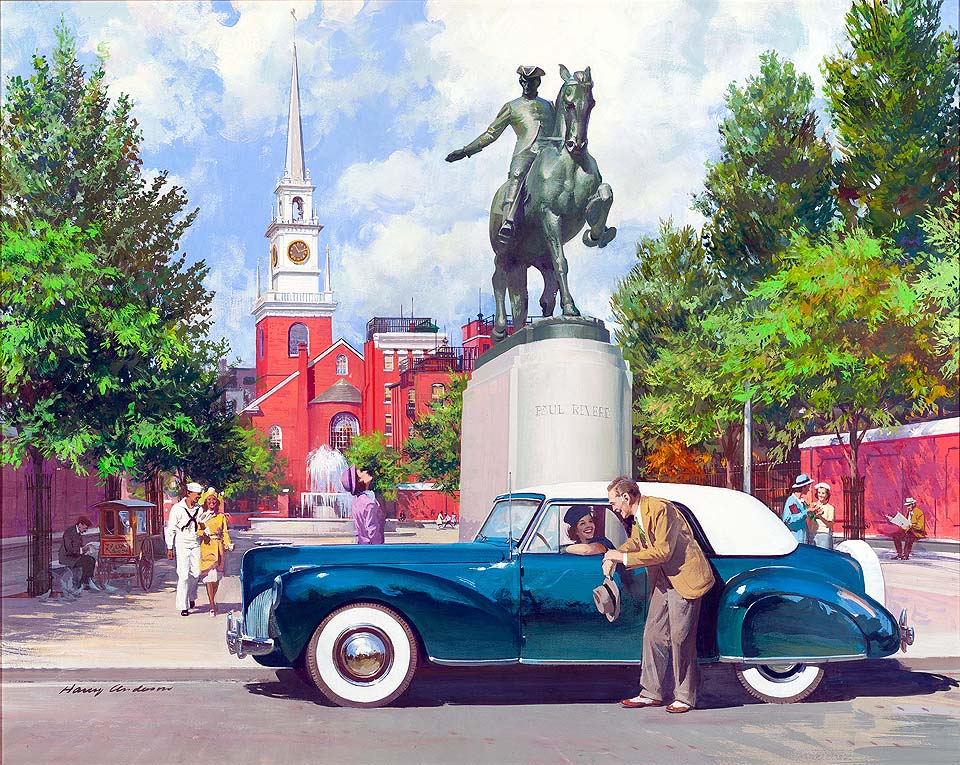
1941 Lincoln Continental: Paul Revere in bronze
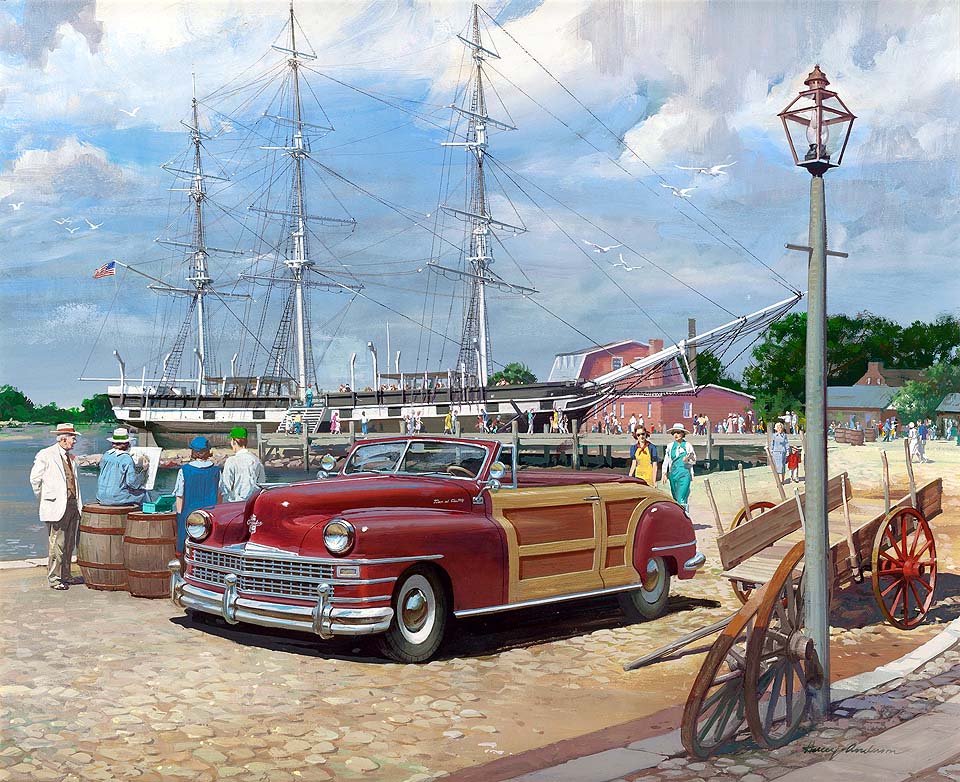
1947 Chrysler Town and Country Convertible: Mystic Seaport
Images: 'Humble Oil & Refining Company' Esso/Exxon Calendars
Happy Motoring !
Do you remember those beautifully illustrated car calendars from the 1960's and 70's? Exxon produced and distributed them at their service stations, along with road maps (remember them?). Well, if you ever saw or owned one of these calendars, you probably had no idea that it would become a collector's item. And you may not have known the name or reputation of the artist behind them. His name was Harry Anderson.
Born in 1906 Chicago to Swedish parents. Harry enjoyed a stable family life and showed early proficiency in mathematics. A math major at the University of Illinois, Harry took a painting class as a breather from the challenging major course requirements. Here he discovered his talent and love for drawing, and his path changed direction. He enrolled at the Syracuse (NY) School of Art in 1927 and graduated with honors in 1931. His "mid-course correction" changed forever his career and his life. Though it took more than a year during the Depression Era to make his first magazine illustration sale, he eventually became one of America's foremost illustrators. By 1937 he began work on a national advertising campaign for Sealed Power Piston Rings; by the late 1930's and 1940'; Harry had established himself as a much sought-after illustrator for the major magazines of the day, including Collier's, Cosmopolitan, Good Housekeeping, Ladies' Home Journal, Redbook and The Saturday Evening Post, among others. He married Ruth Huebel in 1941 and enjoyed a long and successful career illustrating for many religious publishing houses, often accepting only minimum wage for these latter efforts.
Harry's art earned many accolades during his lifetime, including the prestigious New York An Directors Club Award, membership in the National Academy of Design, and induction into the Society of Illustrators Hall of Fame.
In the Sixties he began painting calendars for Esso (now Exxon Oil Company), creating beautiful images of American landmarks and featuring the classic cars of the era. Called "Great Moments in American History" and "Great Moments in Early American Motoring," these paintings are shining examples of what Harry Anderson was capable of, at a time in his life when many of his generation were in toned retirement. Only Norman Rockwell and Harry Anderson were still supporting themselves as artist/ illustrators into their older age, and both artists' work reflected their high morals and fine characters.
Enjoy these early advertising images and calendar illustrations—they are outstanding and just a small sample of Harry's body of work. Harry Anderson died in 1996 at age ninety; the last of a generation of illustrators from the Golden Age of magazine illustration. His work is still circulated and loved today, especially by a new generation of young readers and artists.
I know many people who were quite well acquainted with Harry Anderson, and each describes him as a rare individual possessed of great talent, varied interests (he crafted models of ships and buggies, hooked rugs, made furniture, carved wood) and remarkable humility. I It was a wonderful husband and father, and left a legacy—personal and artistic—that continues to inspire and bless others. This was always Harry Anderson's highest aim.
Source: Harry Anderson, Artist Extraordinaire by Victoria Wilson
----------------------------------------------------
L'automobile heureuse !
Vous souvenez-vous de ces calendriers de voitures magnifiquement illustrés des années 1960 et 70 ? Exxon les a produits et distribués dans leurs stations-service, accompagnés de cartes routières (vous vous en souvenez ?). Eh bien, si vous avez déjà vu ou possédé un de ces calendriers, vous n'aviez probablement aucune idée qu'il deviendrait un objet de collection. Et vous ne connaissez peut-être pas le nom ou la réputation de l'artiste derrière eux. Son nom était Harry Anderson.
Né en 1906 à Chicago de parents suédois. Harry jouissait d'une vie de famille stable et a montré une maîtrise précoce des mathématiques. Major en mathématiques à l'Université de l'Illinois, Harry a pris un cours de peinture pour respirer des exigences du cours majeur. Ici, il a découvert son talent et son amour pour le dessin, et son chemin a changé de direction. Il s'est inscrit à la Syracuse (NY) School of Art en 1927 et a obtenu son diplôme avec mention en 1931. Sa «correction à mi-parcours» a changé à jamais sa carrière et sa vie. Bien qu'il ait fallu plus d'un an pendant l'ère de la dépression pour faire sa première vente d'illustration de magazine, il est finalement devenu l'un des plus grands illustrateurs américains. En 1937, il a commencé à travailler sur une campagne de publicité nationale pour les segments de piston scellés; à la fin des années 1930 et 1940 Harry s'était imposé comme un illustrateur très recherché pour les principaux magazines de l'époque, notamment Collier's, Cosmopolitan, Good Housekeeping, Ladies 'Home Journal, Redbook et The Saturday Evening Post, entre autres. Il a épousé Ruth Huebel en 1941 et a connu une longue et fructueuse carrière d'illustrateur pour de nombreuses maisons d'édition religieuses, n'acceptant souvent que le salaire minimum pour ces derniers efforts.
L'art de Harry a remporté de nombreuses distinctions au cours de sa vie, notamment le prestigieux prix New York An Directors Club, l'adhésion à la National Academy of Design et l'intronisation au Temple de la renommée de la Society of Illustrators.
Dans les années 60, il a commencé à peindre des calendriers pour Esso (maintenant Exxon Oil Company), créant de belles images de monuments américains et mettant en vedette les voitures classiques de l'époque. Appelées "Grands Moments de l'Histoire Américaine" et "Grands Moments de la Première Motricité Américaine", ces peintures sont des exemples brillants de ce dont Harry Anderson était capable, à une époque de sa vie où beaucoup de sa génération étaient en retraite tonique. Seuls Norman Rockwell et Harry Anderson se soutenaient encore en tant qu'artistes / illustrateurs dans leur âge avancé, et le travail des deux artistes reflétait leur moralité élevée et leurs beaux personnages.
Profitez de ces premières images publicitaires et illustrations de calendrier - elles sont exceptionnelles et ne représentent qu'un petit échantillon du travail de Harry. Harry Anderson est décédé en 1996 à l'âge de quatre-vingt-dix ans; le dernier d'une génération d'illustrateurs de l'âge d'or de l'illustration de magazine. Son travail est toujours diffusé et apprécié aujourd'hui, en particulier par une nouvelle génération de jeunes lecteurs et artistes.
Je connais beaucoup de gens qui connaissaient assez bien Harry Anderson, et chacun le décrit comme un individu rare possédant un grand talent, des intérêts variés (il a conçu des modèles de bateaux et de poussettes, des tapis crochetés, des meubles fabriqués, du bois sculpté) et une humilité remarquable. C'était un mari et un père merveilleux, et il a laissé un héritage - personnel et artistique - qui continue d'inspirer et de bénir les autres. C'était toujours l'objectif le plus élevé de Harry Anderson.
Musique : Take me home country roads - 2,71 Mo - 3 mn 18 :
Vous n'entendez pas le son de la page : cliquez ici
Americana Art Museum of Papytane, c'est sur Americana Art Museum of Papytane
Copyright © 2001-
La vraie vie (Get a life) avec Papytane et Mamytane, c'est sur papytane.com
